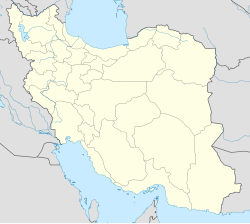Top Qs
Timeline
Chat
Perspective
Ramhormoz
City in Khuzestan province, Iran From Wikipedia, the free encyclopedia
Remove ads
Ramhormoz (Persian: رامهرمز)[a](luri :رومز)s a city in the Central District of Ramhormoz County, Khuzestan province, Iran, serving as capital of both the county and the district.[4] In ancient times it had been known as Samangan, having been established by the Sasanian emperor Hormizd I,[5] although an Elamite tomb has been found as well. The historical territory of Ramshir is in this area, only 3 kilometres (1.9 mi) away from the city.
Remove ads
History
Summarize
Perspective
According to a hadith in Sahih al-Bukhari, Ramhormoz is the ancestral home of Salman the Persian, a companion of the Prophet.[6][7][8]

The proper history of the city begins in the Sasanian era, although there have been Elamite remains found in and around the city as well. The tomb of the Sasanian founder of the city, Hormizd I, is commonly thought to be situated within the city. "With the gradual Muslim conquest of Khuzestan in the 7th century, Rāmhormoz was the scene of a peace agreement between the local Sasanian satrap, Hormozān, and the commander of the Muslim army.".[9]
During the Islamic times, it was remarked by Muslim geographers that the city contained a library comparable only to the one in Basra in the wealth of its collection, and that silk was produced in the city and distributed to distant lands.[10][11] The city enjoyed incredible opulence before entering a state of decline.
Ramhormoz was the location in which Elamite was last reported to be spoken. This report was written circa 988 AD by Al-Muqaddasi, characterizing the local Khuzi people as bilingual in Arabic and Persian but also speaking an "incomprehensible" language. The town had recently become prosperous again after the foundation of a market. As it received an influx of foreigners and being a "Khuzi" was stigmatized at the time, the language probably died out in the 11th century.[12]
The 14th-century Muslim Amazigh traveler and explorer ibn Battuta visited the city during his travels and described the city as "a fine city with fruit-trees and rivers."[13]
From late Safavid until Qajar Iran, the allegiance of the city frequently shifted between Khuzestan and Fars province. In the 18th and 19th centuries, Lurs and Arabs started to settle within and around the city from nearby lands.[14]
Remove ads
Demographics
Language
Ramhormoz people speak Bakhtiari dialect like Masjid Suleiman and Aghajari.[15]Iranica has clearly considered the language of the communities living in Ramhormoz to be Southern Luri.[16]Ramhormzi dialect is a pseudo Bakhtiari dialect.[17]The language of the people of Ramhormoz (also called Romsi) is Bakhtiari dialect.[18]Ramhormzi's accent is the same as Lori Bakhtiari's, which is slightly different.[19]
People
The people of Ramhormoz are from the Bakhtiari tribe and from the Chaharlang tribes, and there are tribes from other tribes such as Khodri of Dashtestan, Zarezadeh, Bigdali, and Talavari.[20]
Population
At the time of the 2006 National Census, the city's population was 49,822 in 10,966 households.[21] The following census in 2011 counted 69,869 people in 17,046 households.[22] The 2016 census measured the population of the city as 74,285 people in 20,127 households.[2]
Remove ads
Climate
Summarize
Perspective
Ramhormoz has a hot semi-arid climate (Köppen climate classification: BSh).
See also
- Tashkooh mountain
- Abū Muḥammad al-Ḥasan ibn ʻAbd al-Raḥmān ibn Khallād al-Rāmahurmuzī—an early Islamic scholar and hadith specialist
![]() Media related to Ramhormoz at Wikimedia Commons
Media related to Ramhormoz at Wikimedia Commons
Notes
References
Wikiwand - on
Seamless Wikipedia browsing. On steroids.
Remove ads



